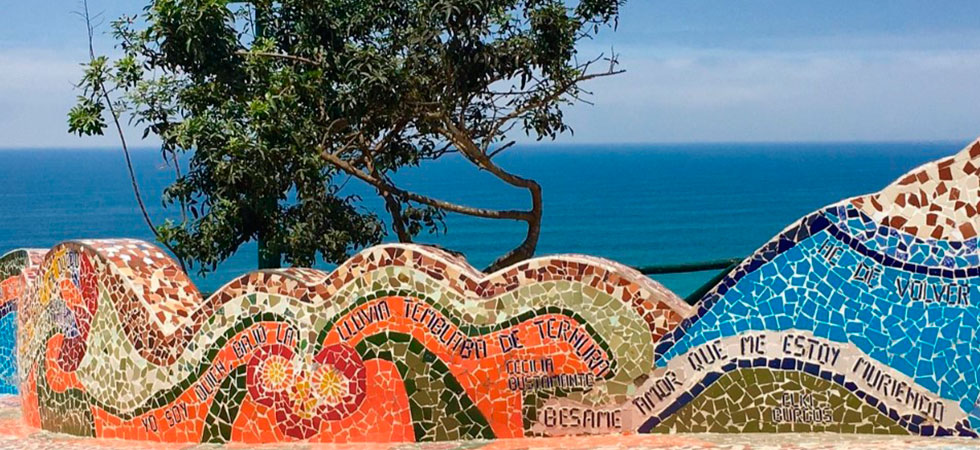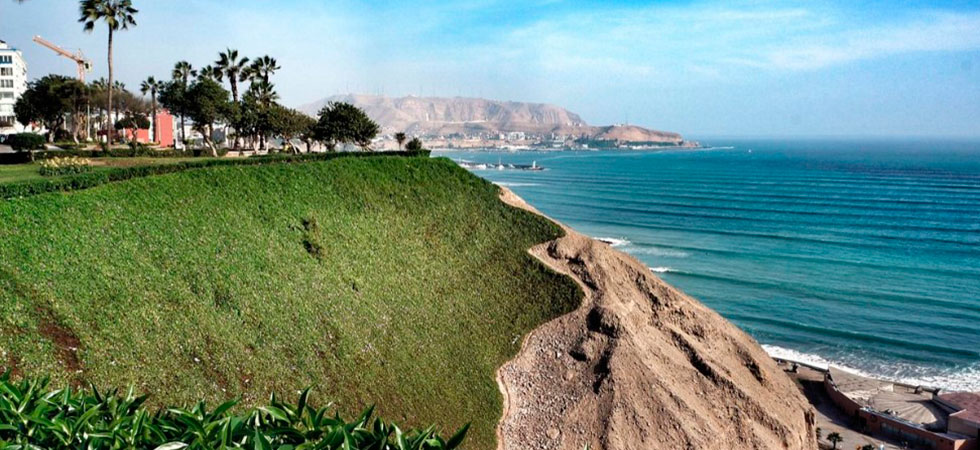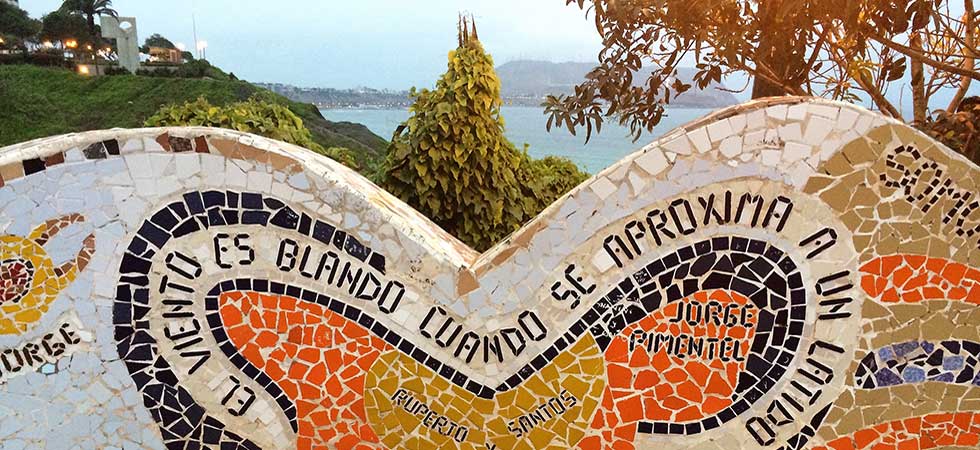Lima’s neighborhoods
Lima, the capital city of Peru, is a vibrant and diverse metropolis with many neighborhoods, each offering unique characteristics and attractions. Some of the most notable neighborhoods in Lima are:
Miraflores
Miraflores is one of the most popular and upscale neighborhoods in Lima. It is known for its beautiful parks, scenic coastal cliffs overlooking the Pacific Ocean, trendy shopping centers, and a bustling restaurant and nightlife scene. Miraflores is a top choice for tourists due to its safety and the variety of accommodations available.
Situated along the picturesque coastline of the Pacific Ocean, Miraflores offers a perfect blend of modernity and natural beauty. To get here, you can easily take a taxi or use public transportation, such as buses or the Metropolitano bus system, which connects the district to other parts of the city.
Once in Miraflores, there are plenty of things to see and do. Start your visit by strolling along the Malecón, a cliffside boardwalk with stunning ocean views. Nearby, you'll find the Parque del Amor (Park of Love), known for its iconic sculpture and romantic atmosphere. Additionally, Larcomar, an upscale shopping center built into the cliffside, offers a variety of shops, restaurants, and entertainment options.
For those interested in art and culture, the Huaca Pucllana is a must-visit archaeological site within Miraflores, providing insight into the region's ancient history. The Amano Museum showcases an impressive collection of pre-Columbian textiles, while the Pedro de Osma Museum exhibits colonial art and artifacts.
When it comes to dining, Miraflores boasts an eclectic culinary scene. Five top-notch restaurants to try are:
- Central: An internationally acclaimed restaurant, known for its innovative and avant-garde approach to Peruvian cuisine.
- Maido: A renowned fusion restaurant combining Japanese and Peruvian flavors, offering a delightful Nikkei dining experience.
- La Mar: Specializing in seafood and ceviche, La Mar offers a vibrant atmosphere and delicious coastal dishes.
- Astrid & Gastón: Owned by celebrity chef Gastón Acurio, this restaurant serves contemporary Peruvian cuisine in an elegant setting.
- Isolina Taberna Peruana: A popular spot to savor traditional Peruvian dishes in a charming and cozy tavern-style environment.
For a delightful nightlife experience, Miraflores has you covered with various bars and clubs. Head to Ayahuasca Restobar for an immersive Peruvian ambiance or Huaringas Bar for craft cocktails and live music. As for accommodation in Lima, Miraflores offers a range of options to suit different budgets. Some recommended hotels are:
- Belmond Miraflores Park: A luxurious 5-star hotel with breathtaking ocean views and excellent amenities.
- JW Marriott Hotel Lima: Another upscale choice boasting stunning sea panoramas and a prime location.
- Hotel Casa Andina Premium Miraflores: A more affordable yet stylish option with comfortable rooms and a great location.
But MIraflores does certainly not only offer expensive hotels en restaurants, there are some great hostels, cafes, bars and restaurants for all type of travelers, from backpackers to upscale.
 Parque del amor Lima Miraflores
Parque del amor Lima Miraflores
Barranco
Barranco is an artsy and bohemian neighborhood with a rich cultural heritage. It is famous for its historic architecture, vibrant street art, and numerous art galleries, cafes, and bars. Barranco also has a beautiful seaside promenade and is a hub for artistic and cultural events.
Nestled along the coast, Barranco is a charming and artistic neighborhood that exudes a laid-back, bohemian vibe. To reach Barranco, you can take a taxi, ride-sharing service, or utilize public transportation options like buses or the Metropolitano bus system.
Barranco is a treasure trove of cultural and artistic delights. Begin your journey by wandering through its colorful streets adorned with captivating street art and historic architecture. The Bridge of Sighs (Puente de los Suspiros) is a romantic spot, and the Bajada de Baños offers access to the beach, where you can enjoy beautiful sunsets over the Pacific Ocean.
This neighborhood is a haven for art enthusiasts. Explore various art galleries showcasing the works of local and international artists. Don't miss the MAC (Museum of Contemporary Art) Lima, which houses an impressive collection of contemporary art from Peru and Latin America.
For those seeking a taste of Barranco's vibrant nightlife, numerous bars and live music venues await. Ayahuasca Restobar is a popular choice for its unique setting within a historic mansion, while La Noche de Barranco is a legendary live music venue attracting both locals and visitors. Food lovers will find Barranco equally delightful. From street food to upscale eateries, the neighborhood offers a diverse culinary scene. Five notable restaurants to try are:
- Isolina: A renowned restaurant specializing in traditional Peruvian cuisine, serving up mouthwatering dishes full of flavor.
- Maido: Canta Rana: A local favorite, Canta Rana offers exceptional seafood and ceviche in a warm and welcoming atmosphere.
- Amoramar: This charming spot boasts an inviting ambiance and serves up delicious seafood dishes with a Mediterranean twist.
- La Lucha Sanguchería Criolla: A must-visit for trying Peru's famous sandwiches, also known as sanguches.
- Burrito Bar: Satisfy your craving for Mexican cuisine with tasty burritos and tacos.
As for accommodation, Barranco has some excellent options for a comfortable stay. Three recommended hotels are:
- Hotel B: A boutique hotel blending historical elegance with modern amenities, perfect for an upscale experience.
- Casa Republica Barranco Boutique Hotel: A stylish and cozy boutique hotel offering a relaxing atmosphere.
- Selina Lima: A trendy and budget-friendly option with a hip hostel atmosphere and a great social scene.
Barranco's unique ambiance, thriving art scene, delicious food, and lively nightlife make it an enchanting neighborhood that you won't want to miss during your visit to Lima, Peru. Enjoy your time exploring the bohemian charm of Barranco!
Historic Center (Centro de Lima)
The Historic Center of Lima is a UNESCO World Heritage Site and holds great historical significance. It features stunning colonial architecture, including the Plaza de Armas and the Government Palace. While some areas of the Historic Center have been revitalized, others might require more attention in terms of preservation.
The Historic Center of Lima is a captivating UNESCO World Heritage Site and the heart of Peru's rich history and cultural heritage. To explore this historical gem, you can take a taxi, ride-sharing service, or use public transportation from any other neighborhood in LIma, as the area is well-connected to other parts of the city.
The Historic Center of Lima, also known as Centro de Lima, is a treasure trove of colonial architecture, grand plazas, and historical landmarks. Start your journey at the Plaza de Armas, the main square, surrounded by impressive buildings such as the Government Palace, the Cathedral of Lima, and the Archbishop's Palace. The plaza is a bustling hub with street vendors, musicians, and locals enjoying their day; here you can marvel at the well-preserved colonial buildings with intricate balconies and façades. The Convent of San Francisco, with its striking yellow façade, is a must-visit. Explore its catacombs and library, which houses ancient texts and manuscripts.
History and culture enthusiasts will find several museums to delve into. The Museo de la Nación showcases Peru's diverse history, while the Casa de la Literatura Peruana celebrates the country's literary heritage.
The Centro de Lima also offers a rich gastronomic experience. Don't miss out on trying traditional Peruvian dishes at restaurants like Cordano Bar, renowned for its hearty Peruvian stews and sandwiches.
For a taste of Lima’s vibrant nightlife, explore the lively Jirón de la Unión street, lined with bars, cafes, and theaters. For a unique experience, head to the Gran Teatro Nacional to catch a live performance or cultural event.
When it comes to accommodation, there are some great options to choose from:
Hotel Bolivar: An elegant and historic hotel with a central location, offering a glimpse into Lima's past.
Hotel Maury: A classic hotel with a traditional ambiance and excellent service.
Hotel Plaza Mayor: A comfortable and modern option just steps away from the main square.
Exploring the Historic Center of Lima is like stepping back in time, where the past and present intertwine to create a vibrant and culturally significant experience. Embrace the charm of this historical district and immerse yourself in the rich tapestry of Lima's fascinating heritage.
 Barranco coastline
Barranco coastline
El Callao
Callao is an important and distinct district of Lima, Peru, located adjacent to the city. Callao is actually an entire province with several districts within it, and it serves as the principal seaport of Peru. It is a crucial economic and industrial hub, handling a significant portion of the country's import and export activities. As a major port city, Callao plays a vital role in the nation's commerce and international trade.
The district of Callao has a rich maritime history and is known for its cultural heritage, including traditional music and dance forms like the marinera. Visitors can explore the Real Felipe Fortress, an iconic colonial-era military structure that has been well-preserved and now serves as a museum.
While Callao is an essential part of the Lima Metropolitan Area and offers historical significance, it is important to note that it has faced various challenges in terms of security and development. Some areas within Callao might not be as safe for tourists compared to more tourist-oriented neighborhoods within Lima, such as Miraflores or Barranco. If you plan to visit Callao, it is best to stick to well-known tourist attractions, and take necessary precautions to ensure a safe and enjoyable experience.
Pueblo Libre
Pueblo Libre is a charming and historic district located in the Lima Metropolitan Area, Peru. It is situated to the east of downtown Lima and is bordered by the districts of Magdalena del Mar, San Miguel, Jesus Maria, and Breña.
Pueblo Libre is known for its well-preserved colonial architecture, making it a fascinating destination for history and culture enthusiasts. The district was once home to several prominent figures in Peru's history, and many of their houses have been converted into museums, showcasing valuable artifacts and providing insight into the country's past.
One of the most famous attractions in Pueblo Libre is the Larco Museum, a private museum housed in an 18th-century mansion. The Larco Museum features an extensive collection of pre-Columbian art and artifacts, including ceramics, textiles, and gold and silver pieces. It is an excellent place to learn about Peru's ancient civilizations and their artistic achievements.
Another notable museum in Pueblo Libre is the National Museum of Archaeology, Anthropology, and History of Peru. This museum exhibits an array of archaeological treasures and historical items, providing a comprehensive overview of Peru's diverse history.
The district of Pueblo Libre also offers pleasant parks, tree-lined streets, and a mix of residential and commercial areas. It has a relaxed and friendly atmosphere, making it a great place to explore on foot.
Pueblo Libre has a variety of restaurants and cafes that cater to both locals and visitors. Here, you can sample delicious Peruvian dishes and experience the country's culinary delights.
Overall, Pueblo Libre is a nice neighborhood in Lima that combines history, culture, and a laid-back ambiance. It is a hidden gem for travelers seeking to delve into Peru's past while enjoying a quieter and more authentic side of the city.
San Miguel
San Miguel is a primarily residential neighborhood with a mix of commercial and industrial areas. It is situated on the western edge of the city, along the coast, and is bordered by the districts of Magdalena del Mar, Pueblo Libre, and Callao.
The district is known for its relatively tranquil and family-friendly atmosphere, making it a popular choice for those seeking a more peaceful living environment while still being close to the city center.
San Miguel offers various parks and green spaces, providing recreational opportunities for residents and visitors. The district also has its share of shopping centers, restaurants, and local businesses that cater to the needs of the community.
One notable attraction in San Miguel is the Parque de las Leyendas, a large zoo and archaeological park that showcases Peru's diverse wildlife and pre-Columbian history.
While San Miguel may not be as well-known for its tourism as neighborhoods like Miraflores or Barranco, its convenient location relatively nearby the airport can make a nice choice for those looking to experience local life in Lima while avoiding the busier and more touristy districts, at a lower price.
Magdalena del Mar
Magdalena del Mar, situated to the west of Lima's city center, is a coastal district with an intriguing history. Originally envisioned as a fashionable spa and resort akin to neighboring Miraflores or Chorrillos in the early 20th century, it has evolved into a predominantly residential area. Known as Marbella in its early days, locals affectionately refer to it as Magdalena.
Today, Magdalena del Mar boasts well-preserved historic streets, and its central market offers a delightful abundance of goods. Among the district's highlights are the "Inmaculado Corazón de María" church at the end of Av. Brasil and the statue of Tupac Amaru II, a revered indigenous leader who spearheaded a significant uprising against Spanish rule in Peru in 1780. The main plaza is a must-see spot.
The district's maintained "malecon" or coastal boardwalk is a delightful attraction, offering breathtaking views of the Pacific Ocean and scenic green areas to enjoy. Magdalena del Mar, with its charming blend of history and residential tranquility, provides an enriching experience worth exploring when visiting Lima.
 Miraflores Lima Peru
Miraflores Lima Peru
Surco
Santiago de Surco is a large district with a mix of residential and commercial areas. It is known for its spacious parks, shopping centers, and entertainment options. Surco is a family-friendly neighborhood with various recreational activities.
San Isidro
San Isidro is a more upscale residential neighborhood known for its green spaces, luxurious homes, and high-end shopping and dining options. It is also a financial district, hosting many corporate offices and embassies.
San Isidro is Lima's ‘garden’ district, as it stands out for its green zones and exclusive residential areas. San Isidro also features many of the city's finest restaurants, hotels and concert halls. Despite the building boom, San Isidro has kept hold of the aristocratic atmosphere for which this suburb was known for at the beginning of the century. This can be still clearly seen in the area of El Olivar, where the olive grove that date backs centuries still keeps its charm and many of its original trees. In recent years, the district has become a major financial quarter as many banks and businesses have left downtown Lima to set up their headquarters in modern office blocks. The district features a pre-Hispanic temple, Huallamarca, where concerts and exhibitions are held occasionally.
San Borja
San Borja is a tranquil and organized neighborhood with pleasant parks, museums, and cultural centers. It is a residential area that offers a quieter lifestyle while still being close to other central districts.
La Molina
La Molina is a luxurious residential neighborhood with gated communities and a more suburban feel. It is known for its educational institutions, country clubs, and recreational facilities.